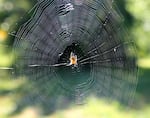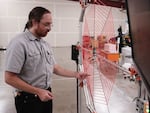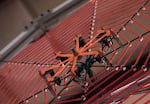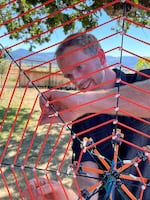Ross Hatton was one of those kids who was fascinated by the creatures from which the rest of us recoil. Think spiders and snakes. He lobbied his mom for permission to keep them as pets, and though she deflected the request, Hatton was not deterred.
“In graduate school, I was lucky enough to be able to join a lab working on snake robots,” explained Hatton, who is now a robotics and mechanical engineering professor at Oregon State University.
After translating the slithering, sliding ways snakes move into robots for more than a decade, Hatton became fascinated by how spiders use silk to swing, make safety lines and interpret vibrations in their webs.
“Spiders that weave webs often have very poor eyesight, and so they understand the world through the vibrations in their webs,” Hatton said. “And it’s a complicated problem. There are many strings vibrating. But I had some engineering tools that I could use as an entry point to start cracking this nut of how does the whole web vibration communicate information to the spider.”
To study this phenomenon, Hatton wound up building a device that recreated the kinds of vibrations spiders would feel in their web and converted them into musical notes. The resulting instrument looks just like a spider web but sounds like a harp.
Hatton’s SpiderHarp captures the essentials of how spiders use web vibrations to interpret worldly signals and pushes the idea from the realm of science to that of art.
Entering the spider’s realm
To begin studying how spiders use web vibrations, Hatton teamed up with spider biologist Damian Elias from the University of California, Berkeley and graduate student Andrew Otto in order to duplicate several of the attributes of real spiders and webs. First of all, orb-shaped spider webs are constructed with stiff, strong radial lines and lighter, springier spiral lines.
“There’s about a 10 to 1 stiffness ratio between the silk that they use for making the radial lines and the spiral lines,” said Hatton.

Orb-weaving spiders use a combination of silk to construct their webs. The silk of the radial lines on this spider web in Milwaukie is about 10 times stronger than that of the spiral lines.
Jule Gilfillan / OPB
Hatton and his team designed computer models to analyze how vibrations travel through complex networks of strings.
“When an insect gets caught in the web, it’s going to get caught on a string, and then that string is going to vibrate. And then because it’s attached to other strings, those strings are going to vibrate,” Hatton explained.
By analyzing the similarity of signals between pairs of receptors or “feet,” along with the strength and frequency of the signal, the “spider” gathers information to determine where the vibrations in the web are coming from.
Hatton’s computer models worked well. But he wanted something tangible he could use to translate the abstract language of engineering to a wider audience. He and his collaborators decided to build an actual web.
Real world problems
Hatton’s first question was: How large should the real-world spider web be?
“The clear answer was 8 feet,” Hatton smirked, playing on the fact that spiders have eight actual feet. “But that was a little bit too big to build in the space,” he said. “And so we cut that in half to about a 4-foot diameter, which then worked out very nicely.”

Oregon State University robotics professor Ross Hatton plucks a string on the SpiderHarp in Corvallis, sending a complex pattern of vibrations through the web in July 2022.
Brandon Swanson / OPB
Translating the project’s mechanics into the physical world posed a new set of challenges.
To duplicate the 10 to 1 ratio of web silk, Hatton used parachute cord, which is stiff, and the stretchier shock cord found in hair elastics.
“And then in order to get everything at the right tension, we built the web in a cone shape,” he said.
When stretched flat, the cone shape preserved the proportional relationships between the inner and outer radial cords.
All of the strings have the same tension, he said, so the cords on the outside of the web vibrate at a lower frequency than the cords at the center of the web.
To approximate the way spiders receive vibration in their legs, Hatton and his team came up with a spider made up of eight “legs,” each of which is tipped with an alligator clip and an accelerometer.

Oregon State University scientists created a mechanical "spider" to detect vibrations in a web using alligator clips attached to accelerometers detailed in this still video image taken in July 2022 in Corvallis.
Brandon Swanson / OPB
“Once the information is detected by these accelerometers, it sends the signal to a computer,” he said. “And then the computer looks for properties of the vibration that tell it which string is being plucked. It’s almost like we have an ear listening to each of these radial strands.”
In other words, a spider “listens” to vibrations with its legs like we “listen” to sound with our ears.
Hatton knew that mapping the frequency of web vibrations through a synthesizer would allow a general audience to hear the vibrations expressed as an audible pitch and immediately grasp what was going on.
Manifesting the web into physical shape gave rise to another invention.
“Because it’s about 4 feet in diameter, it’s the size of a large harp,” Hatton said.
That’s where Hatton reached the limit of his musical knowledge.
“I thought this would make a great musical instrument, and I knew I wanted to do it, but I didn’t have someone who could take on the musical aspects of the project,” he said.
Perhaps somewhere in the universal web that connects all things, a magical cord was struck.
“Dope beats”
Not long after Hatton created his SpiderHarp, musician Chet Udell, a professor of biological and ecological engineering at OSU, heard about it.
“I saw a news broadcast of this really cool four-foot spider web,” Udell recalled. “And I was like, ‘This would be a really cool musical instrument.’”
Udell earned his Ph.D. in the unusual combination of music composition and electrical engineering at the University of Florida in 2012.
“I figured if I needed to learn how to make cool synthesizers or make dope beats, that it would be good to have a good knowledge of electronic music and the sciences behind that,” Udell said. “And so I ended up taking electrical engineering classes for my Ph.D.”
When he ran into Hatton at an OSU event, the next phase of the SpiderHarp project kicked off.
To make this harp into a functional instrument, Hatton and Udell had to pick up the pace of the sounds coming from the web as its strings were plucked. As smart as Hatton’s vibration-sensing, synthesizer-voiced computer was, it needed time to analyze the complex data and respond with accurate locations.
“We didn’t care so much at first about being able to detect quickly,” Hatton said. “We just wanted to be able to detect when it was there.”
The speed with which a pluck was expressed as a sound took a long time — like five seconds. And that was way too slow for plucking a tune out on a harp.
Udell and the team spent a year reengineering the computer’s processing speed to allow five plucks per second. It’s a lot faster but still has its limitations.
“It takes some practice, and then it can only detect one pitch at a time,” Udell said. “So, you can’t simultaneously play in two different areas. It can confuse the detection.”
Udell also had to make some tuning adjustments in order for the higher-pitched inner strings to play well with the lower-pitched outside strings.
“I decided to assign every quadrant to a particular pitch on the scale,” Udell said.
These adjustments had the added benefit of giving the harp’s circular layout a certain visual logic.
“It’s a cool layout because if you have a melody for, like, the “Itsy Bitsy Spider—” Udell mimes plucking out the song by rotating his hands around an imaginary circle. ”There’s like a shape to that melody, and you could play that same melody up at a very high octave or a very low octave, but it’s still the same shape, and … you need to learn that shape once to play that same melody,” he explained.
Show time … sort of
With most of the bugs worked out, Hatton and Udell started holding SpiderHarp concerts paired with science lectures.
In 2019, they were finalists at the Guthman International Musical Instrument Competition hosted at Georgia Tech.
Back in Oregon, the SpiderHarp performed at the 2019 Da Vinci Days Science Festival. When the COVID-19 pandemic hit, the project went into hiatus.

OSU engineering professor Chet Udell plays the SpiderHarp at Emerson Vineyards in August 2022 in Monmouth.
Jule Gilfillan / OPB
The SpiderHarp returned to public performance at Emerson Vineyards in Monmouth in August 2022. But no further performances are currently scheduled.
“Like many arachnids, this one will be entering a diapause in the colder months,” said Udell, who hopes more concerts will come next summer after this seasonal hibernation. He’d also like to get the SpiderHarp a more permanent home in a children’s museum or gallery space.
Both Hatton and Udell see value in combining artistic and scientific performance together in one space.
Udell said he wonders if spiders consider the same kinds of issues they’re pondering as they study how vibrations make their way through spiderwebs. “Maybe in the process of making this thing, we’re enhancing our understanding of this other species,” he said.
And maybe demystifying the ways these creatures interpret the world will make them seem less creepy.
